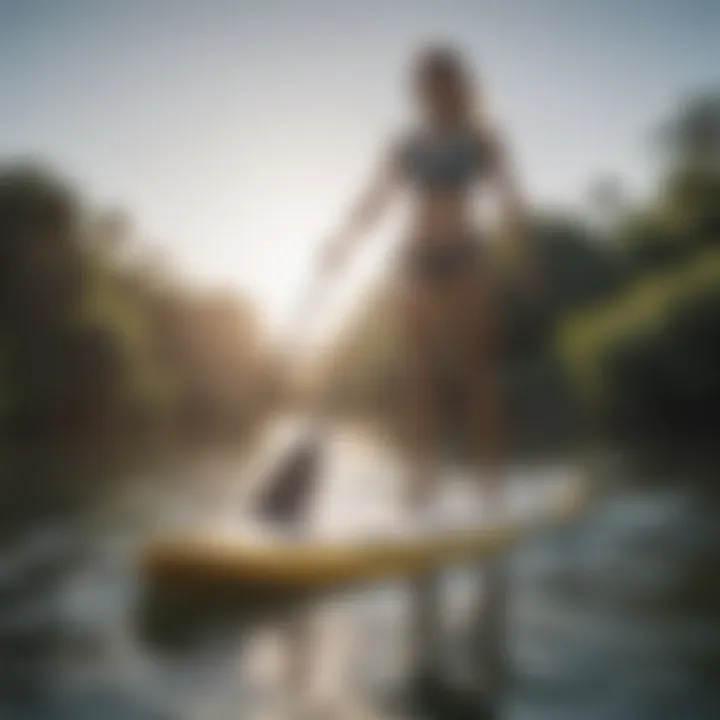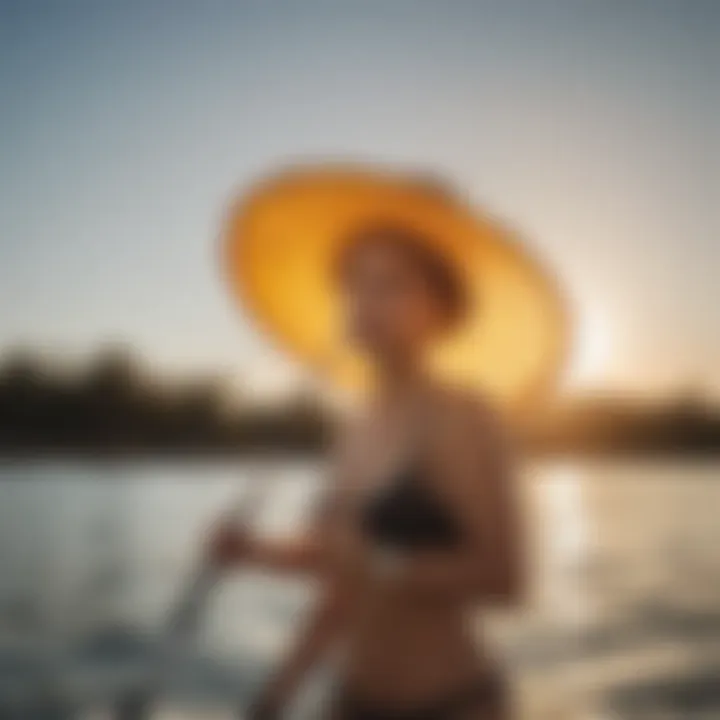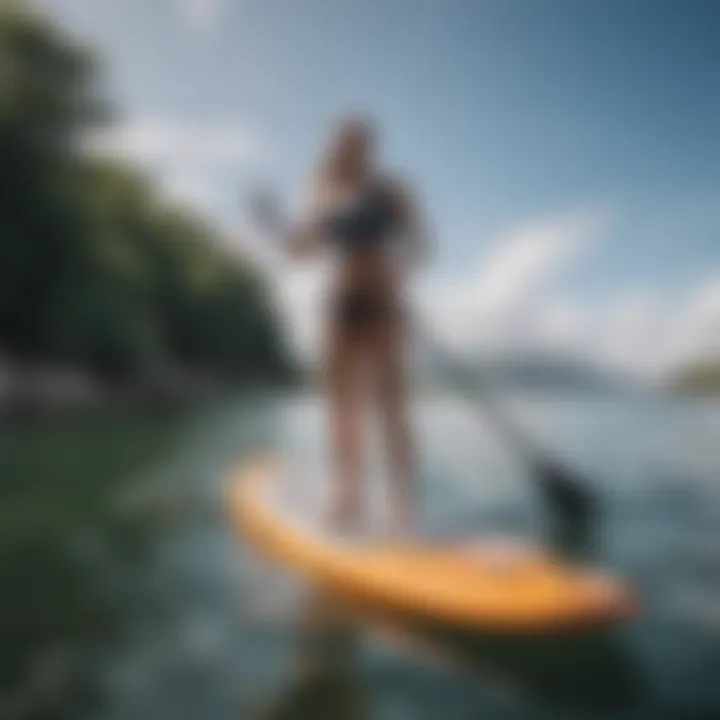Essential Attire for Stand Up Paddle Boarding


Intro
Choosing the right attire for stand up paddle boarding is not just about fashion; it’s a matter of comfort and safety. Whether you’re a seasoned pro or just dipping your toes into this invigorating sport, understanding what clothing and gear to wear can significantly enhance your experience on the water. The right outfit acts as a second skin, allowing you to paddle freely, stay protected from the sun, and deal with water conditions without compromising your enjoyment.
In this guide, we will break down essential clothing choices, materials that work best for different situations, and some handy tips on accessories that can improve your overall paddle boarding journey. You’ll find that clothing selection is not a one-size-fits-all situation; it varies widely based on the weather conditions, location, and your level of expertise.
From sun-soaked beaches to brisk morning lake outings, what you wear can make the difference between a pleasant paddle and a regrettable experience. With that in mind, let’s dive into the initial gear recommendations that will set you up for success.
Gear Recommendations
Essential Gear for Beginners
When you're just starting out, simplicity is key. For most beginners, a swimsuit or quick-drying shorts is a solid choice. Consider opting for:
- Rash Guards: Not only do they provide a protective layer against abrasions, but they also guard against harmful UV rays. Look for a fabric that offers UPF protection.
- Water Shoes or Sandals: Grip is critical when you're standing on a paddle board. Choose footwear that is both durable and suitable for wet conditions.
- Lightweight, Water-Resistant Jacket: Even a sunny day can turn chilly. A packable jacket can be a lifesaver for sudden showers or wind.
Advanced Equipment for Professionals
For seasoned paddlers who are in the water year-round or engage intensely in the sport, consider upgrading to more specialized gear:
- Dry Suits: For cold water environments, a dry suit keeps you warm and dry even if you take an unexpected plunge.
- Neoprene Wetsuits: These are ideal for cooler temperatures, as they provide insulation while allowing for freedom of movement.
- Paddle Board Performance Apparel: Look for high-quality leggings or shorts designed specifically for water sports, offering quick-dry capabilities and compression benefits.
Techniques and Tips
Skill Improvement Strategies
Getting better at paddle boarding isn't just about practice; it's also about wearing the right stuff. Here’s how your attire can help:
- Tailored Clothing: Ensure your gear fits well. Loose clothing can snag, while overly tight gear may limit your movement.
- Wear Layers: In cooler conditions, layering can help you adjust to temperature changes without much fuss. Start with moisture-wicking base layers and move up to insulating and waterproof layers.
Safety Practices and Guidelines
Safety is paramount. Here are a few tips to keep in mind:
Always wear a personal flotation device (PFD) whenever you’re on the water. It's not just a guideline; it’s a lifesaver.
- Hydration Packs: Long sessions can lead to dehydration, so wearing a hydration pack can offer convenience.
- Sunscreen: Never underestimate the power of sunblock; choose one that's water-resistant and applies liberally.
By fine-tuning your attire and gear, you're setting the stage for a more enjoyable and safer experience on your paddle board. Stick around as we cover more about specific materials and how to choose the right options based on your environment.
Understanding Stand Up Paddle Boarding
Stand up paddle boarding (SUP) has garnered considerable attention in recent years, evolving from a niche water sport to a beloved recreational activity among many. Understanding the essence of this sport is essential for anyone interested in taking part. At its core, stand up paddle boarding involves balancing on a buoyant board while wielding a paddle, which allows enthusiasts to navigate across various water bodies, from tranquil lakes to roaring ocean surf. The appeal is undeniably widespread; it combines the serenity of being on the water with a unique full-body workout.
Moreover, paddle boarding can be tailored to suit different skill levels, making it accessible to both novices and seasoned athletes. Those first-timers gripping the paddle for the first time may find the experience both exhilarating and daunting. With time and practice, however, many discover the joy of gliding over waves while soaking up nature’s beauty.
Brief Overview of the Sport
Unlike kayaking, which traps the paddler in a narrow vessel, stand up paddle boarding invites its riders to stand tall, soaking in panoramic vistas while propelling themselves forward. The simplicity of the sport is part of its charm; all you need is a board, paddle, and a spirit of adventure. Whether you're aiming for leisurely progress on a flat surface or aiming to catch exhilarating waves, SUP accommodates a myriad of experiences.
What’s more, the social aspect cannot be overlooked. Group paddles often foster a sense of community, allowing individuals to bond over a shared love for the water. There’s something invigorating about floating in sync with others, exchanging tips, or simply enjoying each other's company while spotting wildlife or discovering coastal environments.
Importance of Proper Gear
While the appeal of paddle boarding lies in its ease and accessibility, the significance of appropriate attire goes beyond mere aesthetics. Proper gear is essential for ensuring comfort and safety on the board. When you're on the water, clothing can affect your performance in various ways.
For instance, wearing the right clothing helps to regulate body temperature, keeping you cool under the sun or warm in cool breezes. A good selection of gear can also provide protection from harsh UV rays; you wouldn’t want a sunburn to dampen your joyful experience on the water. Furthermore, the materials you choose can significantly influence your mobility. Lightweight, stretchy fabrics enable unrestricted movement as you pivot and paddle, allowing for better balance and less fatigue over time.
To sum it up, understanding the essentials of paddle boarding means recognizing the importance of proper gear. It's not simply about looking the part—it's about enhancing your experience and ensuring safety while navigating varying water conditions. The right clothing and accessories allow enthusiasts to focus their energy on the sport rather than worrying about discomfort or hazards. With the right preparation, paddle boarding promises an adventure that is both thrilling and rejuvenating.
Selecting the Right Attire
When it comes to stand up paddle boarding, what you wear can make a world of difference. Choosing the appropriate attire is crucial not only for comfort but also for enhancing performance and ensuring safety out on the water. The right clothing can help regulate body temperature, provide protection against the elements, and allow for a full range of motion, which is vital when balancing on a board. Not to mention, wearing suitable attire can improve confidence as you paddle along, whether you’re gliding through a calm lake or navigating choppy surf.
Materials to Consider
The materials you select for your paddle boarding outfit can significantly impact your experience. Here are some essential materials to keep in mind:
Breathable Fabrics
Breathable fabrics are a real game changer when it comes to paddling. They allow moisture and heat to escape from your body while preventing outside elements from getting in. This can be particularly helpful during warmer days when you might work up a sweat from paddling. The best part about breathable materials like polyester or nylon is their lightweight nature. They feel like a second skin, providing that much-needed comfort as you paddle. However, if you're not careful, some cheaper options might not wick moisture effectively, leading to a sticky situation.
Quick-Dry Materials
Quick-dry materials are another essential for paddle boarding. As the name suggests, this fabric dries much faster than traditional cotton. Imagine being in the middle of a sunny day after a dip into the water; wearing quick-dry shorts or shirts means you won't be left feeling cold and soggy. These materials typically incorporate a blend of synthetic fibers, which not only dry quickly but are durable and resistant to fading. Yet, a downside could be that they may not feel as soft on the skin compared to cotton, especially for longer outings.


UV Protection
Given the amount of time spent under the sun, UV protection is key. Clothing specifically designed with UV-blocking technology helps shield your skin from harmful rays. Many brands now produce garments with built-in UPF (Ultraviolet Protection Factor) ratings. This feature is essential, especially if you plan to spend long hours on the water. While most people remember to slather on sunscreen, having an extra layer of UV protection offers peace of mind. That being said, these items can sometimes come with a higher price tag than standard fabrics.
Layering for Comfort
Layering might not be the first thing that jumps to mind when you think about paddle boarding attire, but it can be just as important as selecting the right material. The ability to adjust what you're wearing based on changing conditions is invaluable.
Base Layer
A solid base layer is foundational for comfort while paddling. Ideally made of synthetic or merino wool materials, a good base layer should provide moisture-wicking properties to keep you dry. This layer fits snugly against the skin, ensuring warmth on cooler days without adding bulk. It’s beneficial for those early morning paddles when temperatures might dip. One downside is that if it's too warm, you may feel overheated, affecting your focus and performance.
Insulating Layer
For those chillier days or early mornings, an insulating layer is your best friend. This is typically made from fleece or other insulating materials that help trap heat while still allowing for breathability. When the wind starts to whip up or temperatures drop unexpectedly, having that extra insulation can keep you comfortable and focused on your paddling. While they offer great warmth, insulating layers can be a bit heavy and may restrict movement if too bulky.
Outer Layer
An outer layer is a necessary shield against wind and water. Often made from waterproof materials, this layer protects your base and insulating layers from rain or splashes as you paddle. Lightweight jackets or windbreakers that pack away easily can save you from being caught unprepared. However, if not breathable, an outer layer can lead to overheating in warmer weather.
Attire for Varying Weather Conditions
When it comes to stand up paddle boarding, understanding how to dress appropriately for the weather is paramount. Your attire can make the difference between an enjoyable day on the water and a miserable experience. Not only do changing conditions affect comfort, but they also play a significant role in safety and performance. Whether it’s the blazing sun, unexpected chill, or surprise rain, wearing suitable gear ensures you stay safe and can perform at your best no matter the elements you face.
Hot and Sunny Days
Lightweight Apparel
In the sweltering heat, the last thing you want is to feel bogged down by heavy clothing. Lightweight apparel is designed to keep you feeling fresh and free while paddling. Generally made from breathable materials, these clothes allow for ample airflow, which helps with sweat management. One of the standout characteristics of lightweight apparel is its ability to wick away moisture. This feature comes in handy during hot outings when sweat can quickly turn into discomfort.
On the flip side, using ultra-light fabrics can sometimes lead to less durability, especially if you paddle in rocky areas. Thus, while lightweight clothing enhances comfort, it’s wise to consider how and where you’ll be using it.
Sun Protection Clothing
Sun protection clothing takes things a step further. Designed not just to be light, but also to block harmful UV rays, this type of clothing is becoming increasingly popular among outdoor enthusiasts. A key feature of sun protection clothing is its UPF rating, which indicates how effectively the fabric can shield the skin from UV radiation. This is a major plus for anyone concerned about skin damage from prolonged sun exposure.
However, one drawback can be the price point; high-quality sun protection gear might come at a premium. Yet, the peace of mind knowing you’re shielded from sunburn can outweigh that cost for many paddlers.
Hydration Essentials
Hydration essentials are vital for any paddle boarding adventure, especially in hot weather. It’s crucial to stay hydrated to maintain energy levels and avoid heat-related illnesses. Many paddlers opt for hydration packs or easy-access water bottles to sip on the go. A common choice is the CamelBak hydration pack, which allows for hands-free drinking and minimizes the hassle of needing to stop for a drink.
The unique feature of hydration packs is the ability to carry a significant amount of water while distributing the weight evenly across the back. However, the downside is that they can feel cumbersome for some, especially if the pack is not well-fitted. Understanding your preferences for storing and accessing water while paddling can help you decide what fits your need best.
Chilly or Windy Conditions
Wetsuits
Wetsuits may seem like an intimidating option, but they provide essential insulation in cold or windy weather. They lock in a layer of water against your skin, which is heated by your body, ultimately keeping you warm even in cooler waters. The flexibility of wetsuits allows for a full range of motion while paddling. This adaptability makes them a favored choice for prolonged sessions in colder environments.
However, the fit is of utmost importance. Ill-fitting wetsuits can cause chafing or restrict your movement, so it’s essential to find one that suits your body shape well.
Windbreakers
If chilly wind is in the forecast, you might want to consider investing in a good windbreaker. These jackets are typically lightweight and offer protection against biting winds, enhancing your comfort while paddling. One brilliant characteristic of windbreakers is their packability; they often fold up into small sizes, allowing you to store them easily.
On the downside, keep in mind that most windbreakers don’t provide insulation. If temperatures drop significantly, layering under this outer garment is often necessary for adequate warmth.
Thermal Layers
Thermal layers are indispensable when temperatures start to dip significantly. These materials are designed to trap body heat, maintaining warmth even in low temperatures. A notable feature of thermal fabrics is their ability to wick moisture as well, keeping you dry underneath.
The disadvantage here is that thermal layers can add bulk, which may feel restricting while paddling. Therefore, finding a balance between warmth and flexibility is key.
Rain and Wet Conditions
Waterproof Gear
In the case of rain or wet conditions, waterproof gear becomes your best ally. This type of clothing adds a barrier against water, helping to keep you dry during unexpected downpours. Many choose breathable waterproof jackets that allow moisture from within to escape, preventing that clammy feeling. One significant characteristic of waterproof gear is its seams sealing, which keeps water from seeping in.
Nonetheless, some waterproof materials can feel heavy or less breathable, making them uncomfortable over longer durations if you’re also sweating. Thus, choosing a high-quality waterproof layer is worth the investment.
Quick-Drying Clothes
Quick-drying clothes are essential when paddling in potentially wet situations. Typically made from synthetic materials, they dry considerably faster than cotton alternatives, ensuring that you remain comfortable throughout your paddling session. What sets quick-drying clothes apart is that they often retain little to no moisture. This feature means you can transition from the water to another activity without feeling soggy.
A notable con, however, could be that some quick-drying fabrics may not offer as much insulation in cooler weather. So, while these pieces can be incredibly useful, layering with thermal or waterproof gear should be considered based on your conditions.
Footwear Options
Footwear plays a crucial role, especially on wet or slippery surfaces. Water shoes are commonly favored for their grip and comfort when tackling a board. Many options provide cushioning and support while ensuring water can easily escape, preventing any discomfort from trapped moisture.
On the other hand, the trade-off with water shoes is that they can sometimes lack in going from water to land seamlessly. If you’re looking for versatility for other activities post-paddling, consider how your choice of footwear will impact that.
Staying comfortable and protected in varying weather conditions is vital to fully enjoying your paddle boarding experience.
Footwear Considerations
When it comes to stand up paddle boarding, the right footwear is more than just a fashion statement; it’s about safety, comfort, and functionality on the water. Whether you’re gliding over calm lakes or battling ocean waves, your feet's protection and traction are critical. Aside from keeping you comfortable, suitable footwear helps prevent slips and provides the grip necessary to stabilize your board. Not to mention, wearing the right shoes can also protect your feet from sharp objects, hot sand, or even harsh weather.
Types of Suitable Footwear
Water Shoes


Water shoes are designed specifically for aquatic adventures, making them an excellent choice for paddle boarding outings. They are typically made with lightweight, quick-drying materials that allow feet to breathe while remaining secure on the foot. A critical characteristic that stands out includes their grip, often enhanced by a rubber sole, that ensures stability when moving on wet surfaces.
These shoes feature drainage systems that allow water to flow out instead of pooling inside, which is beneficial when you find yourself splashing around. However, they might lack some of the cushioning seen in traditional athletic shoes, which can affect comfort during longer excursions. Overall, water shoes provide a balance of safety and agility, making them a popular option among paddlers.
Sandals
Sandals bring a different vibe to the paddle boarding experience, offering breathability and ease of slip-on action. Many sandals designed for water sports come equipped with straps and sturdy soles that keep them secure, even when wading in surf. The key feature of sandals typically is their versatility, lending themselves well to post-paddle activities like grabbing a bite or lounging on the beach.
One unique benefit is the ability to easily rinse them off after a day on the water. However, they might not offer the same level of protection as closed shoes, especially in rougher conditions. So, while sandals are a good choice for casual paddling, consider the terrain and expected weather before opting for this option.
Barefoot Options
Some seasoned paddle boarders swear by going barefoot. This option provides a greater sense of connection with the board, enhancing the overall experience and control. The key feature here is the natural feel of the water and board beneath your feet, which may enhance balance.
However, this choice is not without its downsides. Going barefoot leaves your feet vulnerable to the elements and any underwater hazards. Cuts, scrapes, or exposure to cold water can be an issue, especially if the water is less than warm. Consequently, this method may be best suited for experienced paddlers familiar with their environment and aware of potential risks.
Importance of Traction
Traction is a paramount feature to consider when selecting your footwear for paddle boarding. The grip provided by footwear can make or break your experience, impacting stability on the board. With the board shifting beneath you, dependable traction allows you to maintain balance, preventing slips that could lead to falls or injuries.
In summary, being mindful about what you place on your feet could severely improve your paddle boarding adventures. Whether opting for water shoes with their snug fit, sandals offering convenience, or even going barefoot for that ultimate connection, each choice comes with its own set of benefits and considerations. Understanding these options allows you to make informed selections, enhancing both safety and enjoyment on the water.
Additional Accessories
When it comes to stand up paddle boarding, ensuring you have the right accessories can make a world of difference. While the main focus is often on clothing and base gear, these additional essentials are what really tie everything together, helping to enhance both safety and overall enjoyment on the water.
Personal Flotation Devices (PFDs)
Types of PFDs
There are several types of personal flotation devices available that cater to different needs and preferences for those partaking in paddle boarding. Options typically include Type I vests, which offer the most buoyancy and are ideal for rough waters; Type II vests, which are designed for calm waters; and Type III, which are popular among paddlers for their comfort and freedom of movement.
Among these, Type III PFDs stand out as a favorite due to their balance between safety and comfort. They come in various styles, including vests and jackets, that keep you safe without restricting your paddling movements. One unique feature of these devices is the presence of an ergonomic fit, allowing for extended wear without discomfort. However, it’s always crucial to ensure that the PFD is US Coast Guard-approved, meeting safety standards.
Correct Fit and Comfort
Finding a PFD that fits correctly is as important as the type itself. An ill-fitting device can shift, cause distraction, or even impede your safety.
A well-adjusted PFD should sit snugly above your waist, with the straps adjusted to prevent any excess movement. It’s beneficial to try on several options before choosing one, as comfort can significantly affect your confidence on the water. Some PFDs even come with built-in ventilation or moisture-wicking materials, which can add to your comfort during long paddling sessions. However, beware of the balance between snugness and discomfort that could occur if the fit is too tight.
Sunglasses and Sun Protection
Polarized Sunglasses
When paddling, exposure to sunlight is inevitable, hence polarized sunglasses come into play as a critical accessory. Unlike regular sunglasses, polarized lenses can reduce glare from the water, improving visibility and comfort. This unique feature is particularly beneficial for spotting obstacles or navigating through changing conditions.
Choosing a pair that fits well and has a durable frame will ensure longevity in marine environments. While they are an awesome choice for anyone out on the water, it's important to consider that not all polarized sunglasses provide UV protection; so always check for proper certifications to ensure your eyes receive adequate shielding from the harmful rays of the sun.
Sunscreen Selection
Applying sunscreen is perhaps the simplest yet most effective way to protect your skin while paddle boarding. Broad-spectrum sunscreen with an SPF of 30 or higher is highly recommended, as it covers both UVA and UVB rays. Consider waterproof formulas that remain effective even when in contact with water. A unique aspect to look out for is the inclusion of additional moisturizing ingredients, which can counteract the drying effects of windy and sun-drenched conditions.
However, be judicious in applying it before you start your session, and remember to reapply every couple of hours—or more frequently if you're splashing around. One downside to keep in mind is that some sunscreens can affect water environments, so choosing environmentally friendly options becomes a priority.
Headgear for Protection
Hats
Wearing a hat while on the water serves several purposes. They not only provide shade and help keep the sun out of your eyes, but they can help keep you cool in the heat. Look for wide-brimmed hats made of lightweight, moisture-wicking materials that provide extra protection.
A major plus of hats is their ability to stay in place, given a good fit or an adjustable strap. Yet, be cautious—loose hats can easily blow off, becoming a distraction, so secure fit is key.
Waterproof Caps
On the other hand, waterproof caps serve a slightly different purpose, providing a snug fit that limits water exposure to your head. They are ideal for those chilly days or for paddlers who enjoy taking on waves. Waterproof caps can be fantastic during windier conditions, keeping your head warm while not compromising your visibility.
The downside, however, is that they may offer limited sun protection compared to wide-brimmed hats. Choosing between these two accessories essentially boils down to personal preference and the specific conditions one expects to face while paddling.
Understanding Body Comfort While Paddling
When it comes to stand up paddle boarding, your body comfort cannot be overlooked. With extended periods spent balancing on the board, the right clothing can make all the difference. The focus here is on both ergonomics and temperature management. A harmonious blend of these two elements leads to a more enjoyable experience, whether you're gliding across calm lakes or navigating ocean waves.
Ergonomics of Clothing
Freedom of Movement


Freedom of Movement is a key factor to consider. This is where your choices become crucial. Comfort can largely be defined by how naturally you can move while paddling. Clothes that allow for a full range of motion—like stretchy yoga pants or flexible board shorts—enable you to make the most of your paddle strokes. Materials like spandex or nylon blend well; they adapt to your body's shape without feeling restrictive.
For instance, clothing with a snug fit reduces flapping fabric, which can be a distraction. The beneficial characteristic of having clothes that conform to your body is vital in ensuring no extra drag while paddling. In essence, the more unrestricted your movements, the easier it becomes to maneuver your board effectively.
Avoiding Chafing
Next up is Avoiding Chafing. This is not just a minor concern; it can affect your overall performance and enjoyment. Friction as you paddle can lead to painful red marks, which nobody wants. Selecting materials that minimize this risk is crucial. Look for seamless designs or clothing made from soft, moisture-wicking fabrics. This keeps sweat at bay and lessens the odds of sore spots appearing.
With options available like flatlock seams, which lay flat against the skin, you can enjoy longer paddling sessions without the trouble of chafing. The unique feature here is that the right clothing can actually enhance your experience on the water, transforming what could be a painful day into a comfortable one.
Managing Temperature Changes
Temperature fluctuates during paddle excursions, influenced by several factors including time of day and your location. Being prepared for these changes can make your adventure much more pleasant. In hotter conditions, you might opt for lighter fabrics that breathe well. On the flip side, as the sun sets or when facing wind, having layers handy becomes essential.
A good suggestion is to invest in moisture-wicking base layers, which help in regulating your body temperature. As you exert energy while paddling, staying cool is paramount. Conversely, you may find it necessary to employ insulating layers when the temperature dips. This versatility ensures you can adapt based on the environment you find yourself in.
Overall, being conscious of the ergonomic benefits of your attire helps maximize enjoyment. Paying attention to how clothing interacts with your body while paddling prevents discomfort, allowing you to focus on what really matters: navigating the waters with ease and pleasure.
"Comfortable attire makes for a memorable day on the water, it’s simple as that."
Keep these tips in mind to enhance your paddle boarding experience. Choose wisely, and your choice of gear will help you conquer any adventure.
Analyzing Gear Durability
When it comes to stand up paddle boarding, durability is not just a word thrown about – it's a necessity. Choosing gear that can withstand the rigors of the water environment is pivotal to ensuring the longevity of your equipment and your own safety. High-impact environments, exposure to saltwater or fresh water, and extended use can quickly wear down subpar materials. Therefore, understanding how to analyze gear durability is crucial for any paddler looking to make a wise investment in their adventure pursuits.
Choosing Long-lasting Materials
Reinforced Seams
Reinforced seams are often the unsung heroes of paddle boarding gear. They ensure that your clothing holds up against the stresses of paddling, especially during rigorous maneuvers. The primary feature of reinforced seams is their ability to strengthen the areas that experience the most strain. When the seams are reinforced, you’re less likely to find your gear splitting at the seams after just a few uses. This robustness makes it a favored choice for many athletes and hobbyists alike.
One unique characteristic of reinforced seams is the stitching technique used—often employing double or triple stitching. This means that there’s less chance of seam failure, which translates to greater reliability in the long run.
Advantages:
- Reduces the risk of rips and tears
- Extends the lifespan of clothing
Disadvantages:
- May be slightly more expensive than standard seams
Quality Manufacturing
Quality manufacturing goes hand-in-hand with durability. When gear is produced with attention to detail and craftsmanship, you can generally expect longer-lasting performance. Key characteristics of quality manufacturing include rigorous testing and the use of high-grade materials. Brands that invest in quality manufacturing often develop a reputation for being reliable, giving enthusist confidence in their purchases.
One standout feature is that well-manufactured materials tend to have better water resistance and resistance to UV damage. This means that they won't break down after few outings under the sun, which is a common downfall of lesser quality gear.
Advantages:
- Offers reliable protection against elements
- Increases overall gear effectiveness
Disadvantages:
- Higher upfront costs
Maintenance for Longevity
Once you've made your choice regarding durable gear, maintaining it is crucial for ensuring its longevity. Here are some tips to keep your paddle boarding attire and equipment in tip-top shape:
- Regular Cleaning: Clean your gear after each use in salty or murky waters.
- Proper Drying: Allow your equipment to dry adequately before storing it away; this prevents mold and mildew.
- Use Appropriate Storage: Store items in a cool, dry place to avoid degradation from heat and humidity.
Investing in quality gear is not just about initial cost but about the reliability and performance that keep your adventures enjoyable.
By making careful choices and applying consistent maintenance, you can ensure that your paddle boarding gear lasts, permitting you to focus on what matters most — the waves, the water, and the great outdoors.
Final Thoughts on Paddle Boarding Attire
The final discussion about attire for stand up paddle boarding emphasizes a well-rounded approach tailored to individual needs and environmental factors. Selecting appropriate clothing and gear is not merely about comfort; it's about enhancing performance while ensuring safety and security on the water. The right attire allows paddlers to enjoy their experience with decreased levels of distraction and discomfort.
Tuning Attire to Personal Preference
Personal preference plays a significant role in selecting what to wear while paddle boarding. Each individual has unique tastes, from color choices to fabric preferences, that can impact their time on the water. Finding a balance between functionality and personal style is essential. Some paddlers prefer fitted clothing for a streamlined experience, while others might opt for looser garments for enhanced airflow.
- Comfort: Ensure that whatever you wear allows for easy movement. Clothes that restrict motion can lead to fatigue.
- Style: Don't shy away from expressing yourself. Whether it's florals or bold geometrical patterns, your attire can represent your personality.
- Temperature Regulation: Choose materials that align with personal comfort; this means testing different types in various conditions. A synthetic blend might work for one person, where cotton could suit another, despite cotton being slower to dry.
Listening to what your body and environment tell you is crucial. If a certain outfit feels right and performs well, you’ll likely end up enjoying your sessions more deeply.
Staying Informed About New Gear
The world of paddle boarding is ever-evolving, which means there’s a constant flow of new gear entering the market. Staying updated on the latest trends, technological advancements, and innovative materials can make a world of difference. Regularly checking forums on platforms like Reddit not only introduces you to what fellow paddle boarders recommend but also can offer insight about durability and suitability based on actual experiences.
- Research: Use reputable sites to read reviews about new paddle board clothing and gear. Sources like Britannica and Wikipedia can offer background on materials and manufacturing processes.
- Community Engagement: Joining local groups on Facebook or other social platforms can provide firsthand accounts and advice about recent equipment or apparel that has been particularly useful.
- Innovation Awareness: Companies are consistently putting out gear that caters to specific conditions or activities, such as UV protection or enhanced buoyancy. Keeping an ear to the ground means you can adapt your gear to suit your style of paddle boarding, whether you’re a leisurely explorer or a competitive racer.















